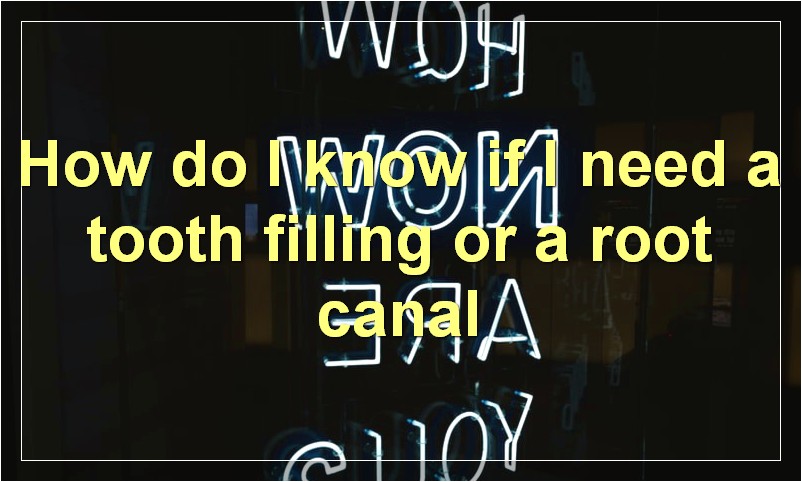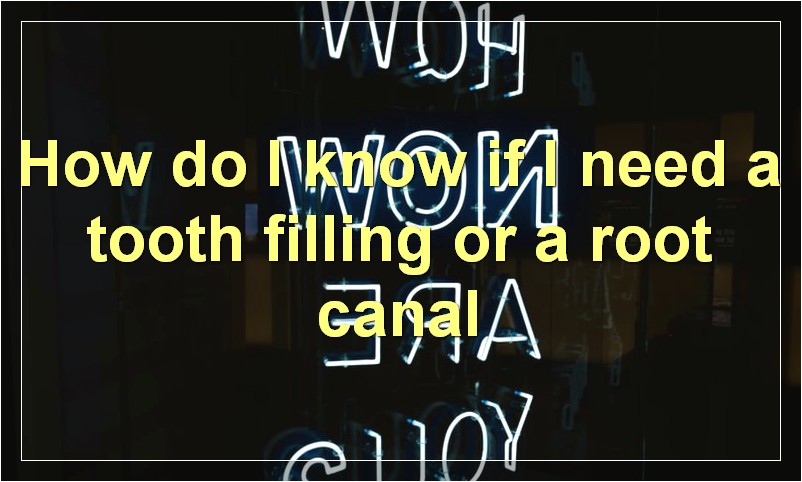If you’re experiencing pain in a tooth, it’s important to determine whether you need a root canal or a tooth filling. Here are some things to look out for to help you make the decision.
How do I know if I need a tooth filling or a root canal?

Most people don’t know the difference between a tooth filling and a root canal. Here’s a quick rundown:
A tooth filling is used to treat a cavity. A root canal is used to treat an infection at the root of a tooth.
Here are some signs that you may need a tooth filling:
1. You have a toothache.
2. You have sensitivity to hot or cold temperatures.
3. You have visible holes in your teeth.
4. You have dark spots on your teeth.
5. You have pain when you bite down.
If you have any of these signs, you should see a dentist as soon as possible. They will be able to determine if you need a tooth filling or a root canal.
What is the difference between a root canal and a tooth filling?
If you’re experiencing tooth pain, then you may be wondering if you need a root canal or a tooth filling. Both procedures are designed to fix damage to the teeth, but they are quite different. Here’s a look at the key differences between root canals and tooth fillings:
Root Canals
Root canals are necessary when the pulp (which is made up of nerves and blood vessels) becomes infected. This can happen due to decay, trauma, or a crack in the tooth. Once the pulp becomes infected, it must be removed in order to save the tooth. The root canal procedure involves removing the damaged pulp, cleaning the inside of the tooth, and then filling it with a special material. Root canals are usually performed by dentists or endodontists (a type of dentist who specializes in treating the pulp).
Tooth Fillings
Tooth fillings are used to repair damage to the teeth that is not caused by infection. This type of damage is typically caused by cavities, which are small holes in the teeth that occur when bacteria breaks down the enamel. Tooth fillings involve cleaning out the cavity and then filling it with a material such as amalgam (a type of metal), composite (a type of plastic), or gold. Fillings can also be used to repair cracked or chipped teeth.
Can I get a root canal instead of a tooth filling?
When you go to the dentist for a routine cleaning, you may be surprised to find out that you have a cavity. If the cavity is small, your dentist will likely recommend a tooth filling. But if the cavity is large, you may need a root canal.
While some people may dread the thought of having a root canal, it’s actually not as bad as it sounds. And in some cases, it may be better to have a root canal than a tooth filling.
Here’s a look at when you might need a root canal and why it may be better than a tooth filling.
What is a root canal?
A root canal is a procedure that involves removing the damaged or infected tissue from inside your tooth. Once the tissue is removed, the tooth is then sealed with a filling or crown.
Root canals are usually needed when the pulp (the soft tissue inside your tooth that contains blood vessels, nerves, and connective tissue) becomes damaged or infected. This can happen due to decay, an injury, or repeated dental procedures on the same tooth.
Why is a root canal better than a filling?
There are several reasons why a root canal may be better than a tooth filling, including:
1. It can save your tooth.
If the damage to your tooth is extensive, a root canal may be the only way to save it. Without treatment, the tooth will eventually fall out or need to be extracted.
2. It prevents infection.
An infection in your tooth can spread to other parts of your body and cause serious health problems. By getting a root canal, you can get rid of the infection and prevent it from spreading.
3. It relieves pain.
If your tooth is severely damaged or infected, it can be very painful. A root canal will remove the damaged tissue and relieve the pain.
4. It’s less invasive than other procedures.
While a root canal does involve drilling into your tooth, it’s still less invasive than other procedures such as an extraction or surgery. And because it’s less invasive, it typically has a shorter recovery time.
5. It’s more affordable than other procedures.
Root canals are generally more affordable than other procedures such as extractions and implants. And if you have dental insurance, most policies will cover at least part of the cost of a root canal.
Is there any way to avoid getting a root canal?
Root canals are one of the most dreaded dental procedures, but they’re actually not as bad as you may think. Here’s what you need to know about root canals and how to avoid them.
What is a root canal?
A root canal is a procedure that is performed when the pulp or nerve tissue inside the tooth becomes infected. The pulp is the soft tissue in the center of the tooth that contains blood vessels, nerves, and connective tissue. The infection can be caused by decay, a crack or chip in the tooth, or an injury to the tooth.
During a root canal, the dentist will remove the infected pulp from the tooth and then clean and seal the tooth. The procedure is usually done in one or two visits to the dentist.
What are the symptoms of an infected tooth?
The symptoms of an infected tooth include pain, sensitivity to hot or cold temperatures, swelling, and redness. If you have any of these symptoms, you should see your dentist as soon as possible.
How can I avoid getting a root canal?
There are a few things you can do to avoid getting a root canal:
-Brush and floss your teeth every day. This will help remove plaque and bacteria from your teeth and gums.
-See your dentist regularly for checkups and cleanings. This will help your dentist find any problems with your teeth early on.
-Wear a mouthguard if you play sports. This will help protect your teeth from injury.
-Don’t chew on hard objects like ice or hard candy. This can crack or break your teeth.
How much does a root canal cost?

Most people dread the thought of having a root canal. After all, it’s not something that we typically associate with being fun. But, if you need one, it’s important to know how much it will cost so that you can budget accordingly.
The cost of a root canal can vary depending on a few different factors. The first is the severity of the infection. If the infection is more severe, then the root canal will likely be more expensive. The second factor is the type of tooth that is affected. Molars tend to be more expensive to treat than incisors. And finally, the third factor is your insurance coverage.
With all of that said, on average, a root canal will cost between $600 and $900. However, if you have insurance, your out-of-pocket costs will be significantly less. In fact, with insurance, you may only be responsible for paying your deductible and coinsurance.
If you’re facing the prospect of having a root canal, don’t panic. Yes, it may not be something that you’re looking forward to, but it’s nothing to be afraid of. And, with today’s technology, the procedure is quicker and easier than ever before. Plus, once it’s over, you’ll be glad that you had it done!
How long does a root canal take?
A root canal is a procedure that can take anywhere from 30 minutes to several hours, depending on the severity of the infection and the number of teeth involved. The average root canal takes about two hours to complete.
Is a root canal painful?
Root canals are one of the most common dental procedures, and they’re also one of the most feared. The thought of having a drill in your mouth is enough to make anyone cringe, but is a root canal actually painful?
The short answer is no. Root canals are not painful. In fact, the procedure is often used to relieve pain that is already present. A root canal is necessary when the nerve of a tooth becomes infected. This can happen due to decay, a crack or chip in the tooth, or an injury. Once the nerve is infected, it can become very painful. A root canal removes the nerve and pulp from the tooth, which eliminates the pain.
Some people do experience some discomfort during a root canal, but it is usually mild and goes away quickly. The dentist will use local anesthesia to numb the area before beginning the procedure. You may also be given sedation if you are particularly anxious about the procedure. After the anesthesia has taken effect, you should not feel any pain. If you do experience any discomfort, it should be very mild and go away quickly.
If you’re considering a root canal, there’s no need to be afraid. The procedure is not painful, and it can relieve the pain that you’re already experiencing. Talk to your dentist about whether a root canal is right for you.
What happens during a root canal?
A root canal is a procedure used to save a tooth that is infected or damaged. The infection or damage can be caused by many things, including decay, an injury, or a crack in the tooth. During a root canal, the damaged or infected tissue inside the tooth is removed and the inside of the tooth is cleaned and sealed. This helps to protect the tooth from further damage or infection.
What are the risks of getting a root canal?
A root canal is a treatment used to save a tooth that has been badly damaged or infected. The procedure involves removing the damaged or infected tissue from inside the tooth, cleaning and disinfecting it, and then filling and sealing it. Although root canals are generally safe, there are a few risks associated with the procedure.
The most common complication of a root canal is inflammation of the tissue around the tooth. This can cause pain, swelling, and tenderness in the gum. In rare cases, an infection can develop in the tissue around the tooth. This can lead to fever, abscesses, and cellulitis.
Another potential complication of a root canal is damage to the surrounding teeth. This can occur if the dentist accidently drills into one of the adjacent teeth. In rare cases, the roots of the adjacent teeth can be damaged during the procedure.
There is also a small risk of developing an allergic reaction to the materials used during the procedure. The most common material that people are allergic to is latex. Other materials that have been known to cause allergic reactions include eugenol (a compound found in cloves) and methohexital (a barbiturate).
Finally, there is a very small risk of developing a nerve injury during a root canal. This can cause numbness, tingling, or pain in the tongue, lips, or gums. In rare cases, paralysis of the muscles of the face may occur.
If you are considering having a root canal, it is important to discuss all of the risks and benefits with your dentist before making a decision.




